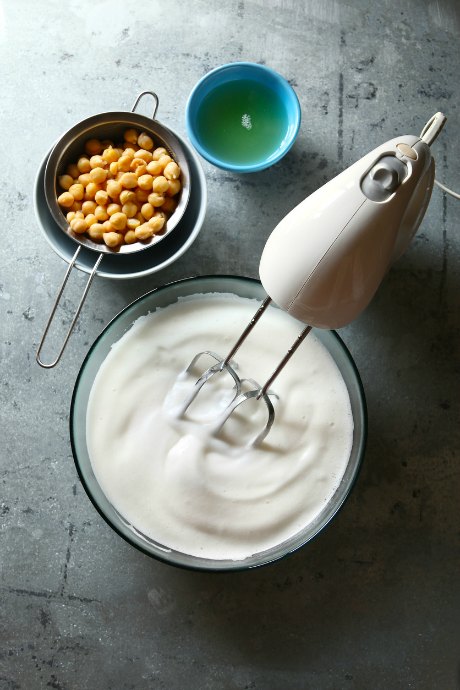Ask the Experts: What Is Aquafaba?
Posted by Julie on Sep 21st 2016
Q: I've heard aquafaba is an ingredient in vegan cooking, but what exactly is it?
A: When you open a can of chickpeas or garbanzo beans, aquafaba is the liquid you rinse off your beans and down the drain. In fact, the name loosely translates to "bean water" and was coined by Goose Wohlt (owner of aquafaba.com) and the Facebook group, Vegan Meringue.
Use an Egg Substitute
When it's drained from beans and poured into a bowl, aquafaba looks a lot like egg whites. In cooking, it behaves a lot like egg whites too. This similarity to egg whites is what makes aquafaba so useful in vegan cooking.
You can substitute aquafaba for eggs in most recipes, especially where eggs are used as a binder. It works in pancakes and waffles, cakes and cookies, and mayonnaise and meringues. You can even use it to make cheese and butter.
Unfortunately, you can't turn aquafaba into an omelet or deviled eggs. Angel food cake hasn't yet been perfected either, though the Vegan Meringue Facebook group continues to experiment in search of a vegan angel food cake recipe.

Key Details You Need to Know
Technically, aquafaba refers to any liquid created from cooking legumes. However, the general consensus seems to be in favor of liquid from white beans, both in terms of color and taste.
You can save aquafaba from cans of chickpeas, or you can save the liquid that's left over from cooking dry beans. In the latter case, you may need to reduce it over heat to make sure it's sufficiently thick and viscous. It needs to have the same consistency as egg whites in order to work properly.
On a Larger Scale
An interesting New York Times article last spring described how vegan LA restaurant Crossroads uses aquafaba in their dishes. It's remarkable that this strategy makes use of what was once considered a waste product of cooking. Plus, although Crossroads has a plant-based menu, that's secondary to their goal to create and serve delicious food.
The same article also covered a smart partnership between Ithaca Hummus and Sir Kensington's condiment company. Instead of disposing of the aquafaba from producing hummus, Ithaca Hummus now sells it to Sir Kensington's for their vegan mayonnaise. And in case you're wondering, the market for vegan mayonnaise is growing fast. This partnership is a win-win for both business and consumers.
Recipes to Try
Want to try using aquafaba at home? Whether you're vegan, vegetarian, or simply want to incorporate more plants into your diet, it's worth checking out.
Of course you can substitute it for eggs using the proportions outlined in the chart above. But if you'd like to see how to use aquafaba in ways that have been tested and perfected, try these recipes for vegan macarons and vegan butter.
Vegan Macarons from The Blenderist
We're impressed by Jasmine's dedication to turning out perfect macarons, as well as the levity she injects into her step-by-step instructions on The Blenderist. Even if you don't intend to make these macarons, go read her recipe.
The trial-and-error process she describes underscores a tip we recently posted on Facebook. Before you attempt macarons, vegan or otherwise, test your oven for hot spots. This article from Bon Appetit tells you exactly how to do it.
Also, before you attempt macarons, make sure you have the proper tools as recommended on The Blenderist. A kitchen scale and a candy thermometer are not negotiable if you want to have gorgeous macarons with perfect feet.
That's right; macarons have feet. Delicious feet.
Vegan Butter from Plante Pusherne, via The Washington Post
Many people say giving up cheese would be the most difficult challenge of eating vegan, but we think giving up butter could be even tougher. But it sounds like whipping up vegan butter is a snap, thanks to this recipe from Nina of the Dutch food blog, Plante Pusherne (as published on The Washington Post).
The prep work is simple, and the ingredients are easy to find. You might even have most of them in your cupboard right now. The butter does take a while to firm up, so make it the night before for the next day.

